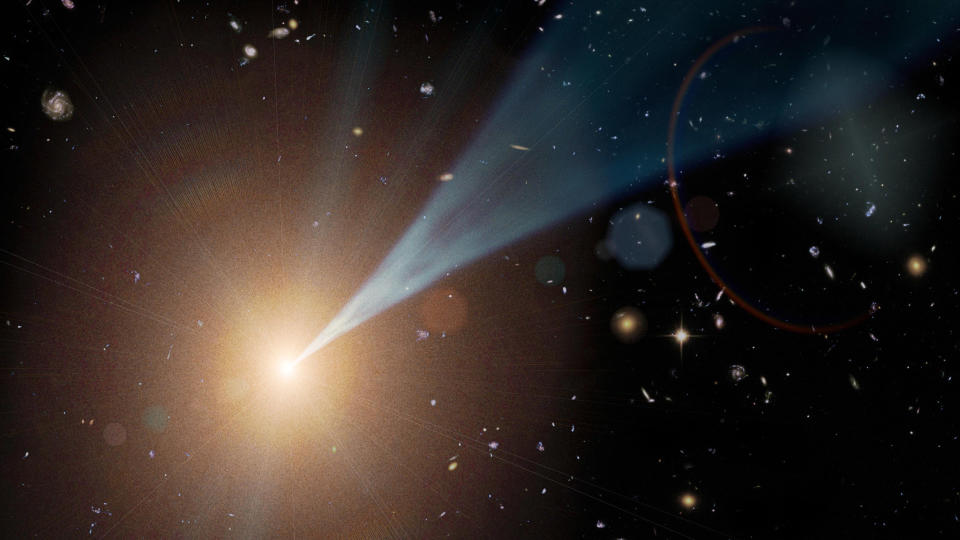100 black hole jets aimed at Earth unleash controversial physics theory

Astronomers are using 100 newly found supermassive black holes as a laboratory for extreme physics experiments.
These black holes are nicknamed 'blazars' because they are shooting explosive jets of matter and radiation directly at Earth. The extreme environments of black holes are perfect to test physics to its limit, one of the study authors said in a statement.
"They provide us with opportunities to study theories of relativity, to better understand how particles behave at high energies, to study potential sources of cosmic rays that arrive here on Earth, and to study the evolution and formation of supermassive black holes and their jets," Abe Falcon, leader of the high energy astrophysics group at Penn State, said in a May 10 statement.
Related: What is a black hole event horizon (and what happens there)?
Blazars launch when some of the matter surrounding a supermassive black hole doesn't fall to its surface, but instead channels to the black hole's poles at speeds approaching that of light. Because jet activity is directly linked to how supermassive black holes gather mass, unveiling this phenomenon could show how these cosmic titans grow to masses equivalent to millions or even billions of times that of the sun.
"Because the jet of a blazar is pointed directly at us, we can see them from much farther away than other black hole systems, similar to how a flashlight appears brightest when you're looking directly at it," research lead author and Penn State astronomy and astrophysics graduate student, Stephen Kerby, said in the same statement. "Blazars are exciting to study because their properties allow us to answer questions about supermassive black holes throughout the universe."
The team found the new blazars while looking at unclassified high-energy cosmic emissions with telescopes. These newly identified blazars are dim in comparison to typical examples of these powerful cosmic objects, which can often outshine the combined light from every star in the galaxy that hosts them. The dimmer blazers allowed the team to test a controversial theory surrounding blazar emissions, called the 'blazar sequence.'
Related: X-ray view shows how supermassive black holes speed up particles in jets

Blazars emit light across the entire electromagnetic spectrum, ranging from low-energy light like radio waves all the way through to extremely energetic gamma rays. The spectrum of light from blazars tends to peak at two specific wavelengths, however: in gamma-ray wavelengths, and in a range of lower-energy wavelengths. (The exact wavelength of these peaks varies from blazar to blazar and can change over time.)
The blazar sequence theory predicts that the lower-energy peak for bright blazars will be more towards the red (or lower-energy end) of the electromagnetic spectrum than the same peak for dimmer blazars. Observations to confirm the theory have been hard to obtain, however.
"With our currently operating telescopes, it's actually very difficult to detect and classify the lower-energy peaked — red — blazars that are also dim, whereas it is much easier to find these blazars when their peaks are at higher energies or when they are bright," Falcone said.
The newer research, by contrast, aims to start "exploring the blazar sequence by delving deeper into lower luminosities of both the low-energy and high-energy peaked blazars," he added.
Related: Where do black holes lead to?

The team looked at a catalog of gamma-ray sources detected by the Fermi Large Area Telescope, finding high-energy emissions that hadn't yet been linked with a low-energy peak from the same source. For each blazar seen in gamma rays, the astronomers found a counterpart emission in X-rays, ultraviolet light, or visible light detected by the Neil Gehrels Swift Observatory. Getting the Swift data from the archive helped the team characterize the light from 106 new dim blazars.
"The Swift telescope observations allowed us to pinpoint the positions of these blazars with much more precision than with the Fermi data alone," Kerby explained. "Pulling together all this emission data, combined with two new technical approaches, helped us identify where in the electromagnetic spectrum the low-energy peak occurs for each of the blazars."
Helping with the search was machine learning (a form of artificial intelligence) and physical modeling, both confirming that the sample of dim blazars generally peaks in the blue, higher-energy light.
RELATED STORIES:
— Black hole jet changes direction as astronomers watch in cosmic first — and it's aimed right at us
— 'Neutrino factories' could hold the solution to the cosmic ray mystery
— Violent supermassive black hole with twisting jet may help Milky Way observations
Going forward, the team will attempt using this dataset to make predictions about the blazars that are still too dim for astronomers to detect directly.
"There are still a thousand Fermi unassociated sources for which we have found no X-ray counterpart, and it's a fairly safe assumption that many of those sources are also blazars that are just too dim in the X-rays for us to detect," Kerby said.
This future study could allow the team to further test the blazar sequence, too. The new work could also show the strength of a blazar jet's magnetic field, and how fast the charged particles within it are moving, Kerby said.
"It's important to always work to expand our datasets to reach dimmer and dimmer sources, because it makes our theories more complete and less prone to failures from unexpected biases," the graduate student said. "I'm excited for new telescopes to probe even dimmer blazars in the future."
The team's research has been accepted for publication in the Astrophysical Journal and was published on the preprint server arXiv on May 3.

